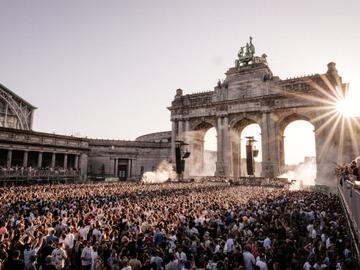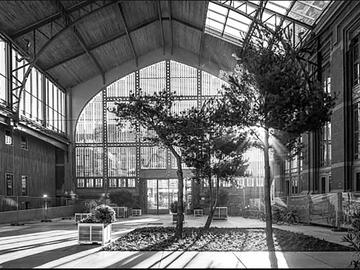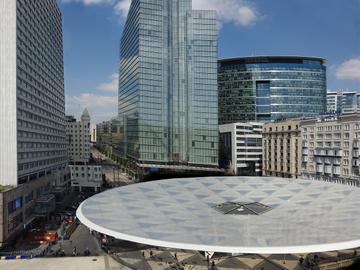The British Magnum photographer Martin Parr has been called the chronicler of our times and was always delighted with the title of photographer-anthropologist-satirist which was bestowed on him. But is the colourful mirror he holds up to us still colourful enough? At Hangar, you can judge for yourself whether people watching has lost its innocence in the current bidding of sensibilities and whether you can still laugh at it at all.
© Martin Parr/Magnum Photos
| Self-portrait, Benidorm, Spain, 1997.
That Martin Parr is considered one of the most important exponents of contemporary documentary photography and one of the most famous photographers in the world. That he is a chronicler of our times, as the renowned German curator and photography critic Thomas Weski also asserts. One that fathoms the world with a mischievous eye and does so by creating strange, often exaggerated or grotesque images in garish colours. This is what it says in black and white on the announcement of “Parrathon”, Hangar's retrospective of the photographer otherwise associated with a typical British sense of humour and who preferably makes pictures of the way we spend our free time, whether we like it or not.
Martin Parr has always been adamant that he makes no distinction between rich or poor, thick or thin, black or white. “I photograph people as I find them,” was the headline above an interview with De Standaard around two years ago. Photographing people in their leisure environment was for him the ideal way to be “democratic”, he once said. “All the classes have free time, so I was able to tackle them all.” So you saw him at work at the horse races and in the VIP lounge of the polo club, but also in the queue at the ice-cream or hotdog stand on a sandy beach crowded with day-trippers. It is his way of hanging an image capturing time and commenting on it in a light-hearted way: “I have never photographed riots in London. That's not my thing.”
I do not have much by way of embarrassment about who I am and what I do; I don’t try to hide behind my camera
In its place is a series like The Last Resort (1983-1986), in which he set out to photograph working people and their families on their outing to New Brighton, England. It was his criticism of the Thatcher regime. Eight years ago, we spoke to the photographer on the occasion of an installation in Knokke. There he mirrored work from his series Luxury (2009) on the boastful people on the dike and told us how he was much more influenced by the work of Tony Ray-Jones, a Somerset photographer who also liked to record people in their spare time and then occasionally puncture their comings and goings with an extra layer of surreal humour, than by the work of Henri Cartier-Bresson. “Ray-Jones was more of a social anthropologist than a photographer, and that's what I've become after forty years of watching people and photographing them. I've always tried to capture the world in my typical way, by how I look.”
It took a while for everyone to understand the series on New Brighton, Parr recalled. “The middle class was angry, especially those who did not know the North of England. But the working class liked it, because they saw themselves. But actually, I didn't think about any of that when I was making the images.” Another quote from that same conversation: “I do not have much by way of embarrassment about who I am and what I do; I don't try to hide behind my camera.”
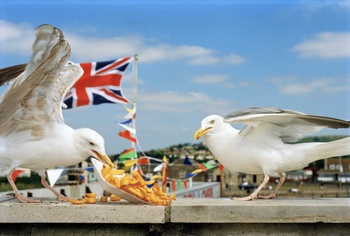
© Martin Parr/Magnum Photos
| Martin Parr’s colourful take on England: the Union Jack witnesses seagulls having a picknick in Dorset, South West England in 1996.
Exactly that way of always looking through the same glasses and shamelessly (and often uninvitedly) recording people as (accidental) passers-by seems to have become problematic in the current era. Suddenly, everyone in every discipline, including photography, is urged to put on different lenses and tactfully to address sensitivities that used to be given little or no thought beforehand. Some will stubbornly continue to call it hypersensitivity. Others adapt, sensing that social relations have shifted – due to a much more diverse society and the emergence of a young, articulate generation that feels connected and empowered by social networks. With apologies for their insensitivities, as does Parr. In recent years the photographer suddenly found himself in the eye of the storm (and the cancellation debate), not even because of photos he had taken himself, and has himself experienced personally how fragile his privileged status and his field of activity – the thin line between watching people and making them look – have become.
AN OLD WHITE MAN
Specifically, Parr had written a new foreword to the reissue of London, a 1969 book of black-and-white photographs by the late Italian photographer Gian Butturini, for whom he had always had a soft spot. Reason for the controversy is a spread featuring, on one side, a black woman in a subway carriage and, on the other, a gorilla in a cage at London Zoo in Regent's Park. Mercedes Baptiste Halliday, a British anthropology student with African roots, was shocked by the juxtaposition, accused Parr of racism via the Twitter account Less Than Human Debate, among others, and, supported by her father Paul, took the lead in protests seeking to cancel the photographer.
Eventually the éminence grise of English documentary photography ended up apologising for letting this pass. He donated the fee he had earned for it to charity and resigned as artistic director of the Bristol Photo Festival. “It's no excuse, but I'm a nearly 70-year-old white man who is woefully slow coming to the realisation that he has failed to see things in a different perspective,” the knee-jerk reaction sounded. But Halliday was unimpressed, comparing him to John C. Calhoun, a U.S. vice president whose statue had just been pulled down in Charleston for defending slavery: “Parr represents a generation of middle-aged white men who do what they want without regard to the consequences.” Fueled by the Black Lives Matter movement, her message resonated.
In recent years Martin Parr suddenly found himself in the eye of the storm (and the cancellation debate), and has himself experienced personally how fragile his privileged status and his field of activity have become
A very different sound could be heard from the children of Butturini. They claimed that while their father's juxtaposition was a provocation, it was precisely to denounce the marginalised position of blacks in English society. So he meant the exact opposite of what they were accusing him of. The fact that the Italian photographer did not quite understand how offensive his juxtaposition was does not in any way absolve him, according to Paul Halliday. “It has to do with entering a new environment, not knowing the context, wanting to take some pictures quickly and then publishing them to a (in this case often equally ignorant) Italian audience.” For Parr and colleagues, if anything, he's even sharper: “The idea of the rock star photographer who can and does do anything without bearing the consequences is definitely over.” Butturini's widow talks about a cancel culture gone mad.
The re-release of London has been taken off the shelves and is only offered for sale via the website of the photographer's relatives, where a statement by Parr was published a few months ago. In it, the photographer stands his ground in the face of the aggressive attacks and accusations of racism that continue to dog him and Butturini, but at the same time strikes a mea culpa: “I will be more aware of the potential impact of my work and that of others. The Martin Parr Foundation's board has (since) become more diverse: we have fellowships for under-represented photographers, organised an open call for a curator of colour and inclusion and equity training for staff and directors.” In the wake of the controversy, there was collateral damage for photo agency Magnum, which admitted to not having enough photographers of colour in its ranks and promised to subject its entire photo collection to a critical review.
ART AND POLITICS
Fearing for his name, fame and career, Parr adopted a low profile during the scandal, with an eye for his shortcomings and limited perspective. Now that the storm has died down and the focus is once again on his work, the artist's ambiguity paradoxically once again proves to be his greatest asset. Compared to the often hurtful, one-dimensional meme culture on the Internet, Parr's photographs are light-hearted witticisms that, while confrontational, are less harsh than the bright colours he uses. This way, Parr mainly fought the ever more ferocious commercialism with its own means. At best, there was that typically British monk's laugh as a liberating side effect for those who grasped the stratification.
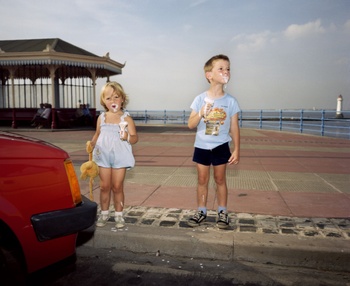
© Martin Parr/Magnum Photos
| Martin Parr: New Brighton, England, GB, 1985.
Inspired by American colour photographers William Eggleston and Stephen Shore, and the vivid postcards of British photographer John Hinde, he was convinced that this in-your-face approach could work. More than that, it became the trademark with which he would conquer museums and galleries worldwide and influence aspiring photographers. Moral of the story: to understand art it can be useful to take in the whole picture and thus both the intention and the context (possibly also the limited perspective) of the artist, otherwise you are mainly concerned with politics and yourself.
MARTIN PARR: PARRATHON
17/9 > 18/12, Hangar, www.hangar.art
Read more about: Expo , Martin Parr , Parrathon , Hangar
